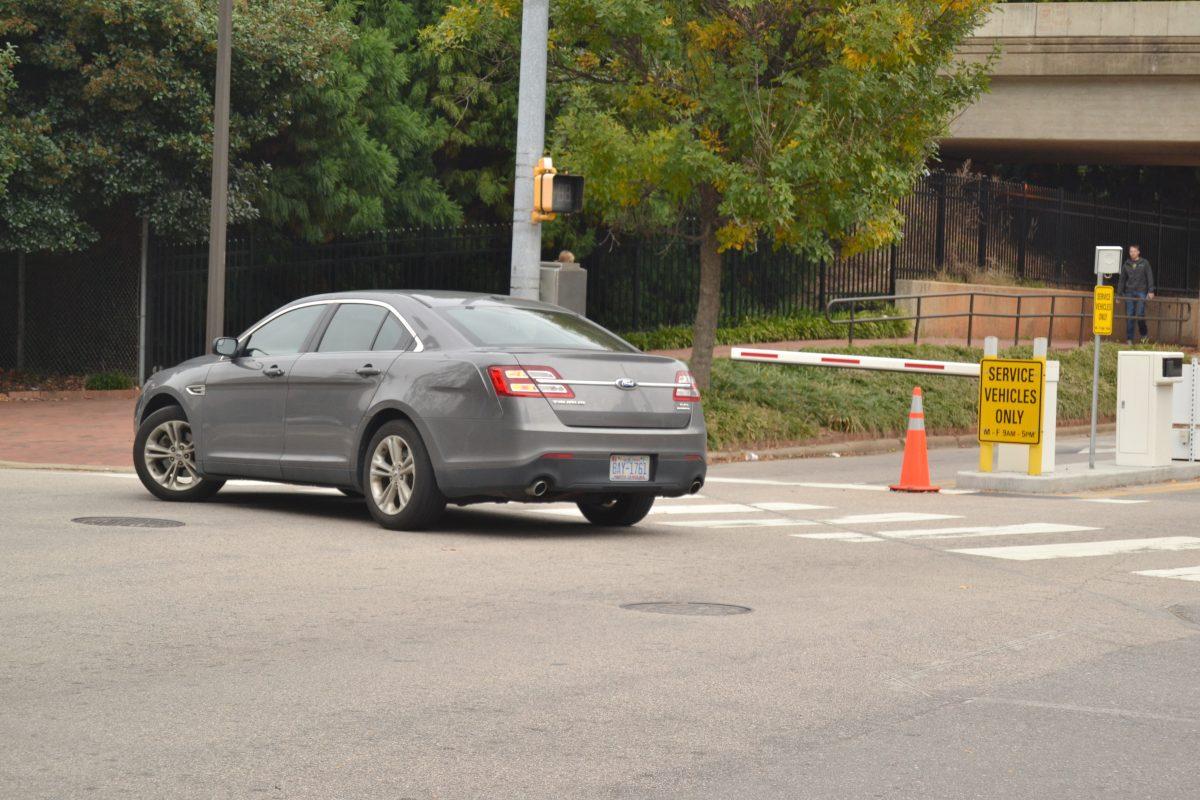
Victoria Crocker
Cars regularly have to perform u-turns when they drive up to the service vehicles only gate on Dan Allen Drive. Photographed by Victoria Crocker.
In January, NCSU Transportation placed a restricted access gate on Dan Allen Drive with hopes to improve pedestrian safety and help ensure a more timely bus system. Although it has been an inconvenience for some drivers, it has been considered a success.
Christine Klein, public communication specialist for NCSU Transportation, said the only vehicles allowed through the gate between 9 a.m. and 5 p.m. are T-transit vehicles, university vehicles with “SV” or “UV” permits and emergency vehicles.
But other drivers unaware of the restricted access often travel down the road and get stuck at the gate, being forced to either make a U-turn or attempt to reverse out.
Additionally, it can just be inconvenient for some students and faculty to get from one side of the campus to the other.
Garren Plemmons, a junior in communication, said that prior to the gate opening, it was easier to traverse the campus.
“Now, I have to go all the way around campus to get to the other side instead of cutting through,” Plemmons said.
Despite this inconvenience, Klein said that many of the goals of this project have been met.
“Pedestrian safety was the primary goal of restricting access,” Klein said. “The Dan Allen Drive gates have been very successful in accomplishing this goal.”
Klein said that the problems some people have is part of the learning curve of the gate, and she hopes the campus visitors, students and faculty will become more accustomed to it.
Michael Ousdahl, transportation planner at the University, said he also hoped that more people would get used to the gate and that it was likely that people getting stuck did not see the signs posted.
Currently, Klein said, there are three signs to notify drivers of the block: one on Hillsborough Street, one on Western Boulevard and one on Dan Allen Drive.
Klein said that only so many signs could be posted, but that making people aware of the gate was important. She said that NCSU Transportation made a major push on communicating the closing off of the street to people on and off campus.
For example, the department reached out to the alumni office so that it could notify alumni returning to campus of the change in traffic.
“As the gate becomes engrained in peoples’ minds here on campus, hopefully we will see less people having to back up and turn around,” Ousdahl said.
Alexis Carson, a sophomore in computer science, said she noticeds a major difference in traffic depending on whether Dan Allen is accessible.
“It seems as though as soon as the gates get opened after 5 p.m., there’s some type of Dan Allen “bat symbol” that shines into the sky signaling everyone to use it,” Carson said.
Jennifer Godwin, a junior in biomedical engineering, said that she thought that students should be allowed to use their identification cards for access through the gate.
Klein said allowing students to access the gate would defeat the purpose.
“We understand it is a learning curve, and we regret any inconveniences it has caused, but our primary goal has to be safety,” Klein said.
Klein said that when Valentine Commons opened, there was even more concern for traffic with a 900-bed facility being added.
“There is a constant stream of pedestrian traffic trying to cross Dan Allen and, I think, it could have escalated into something very unsafe if something had not been done,” Klein said.
According to Klein, there was a great amount of research concerning the placement of the gate. During the planning phase, there were other options discussed and there was a possibility of more of Dan Allen being blocked.
“Dan Allen has been a traffic congestion gridlock problem for many years,” Klein said. “This is the first real time it has been addressed and for the most part we think it has been positive.”
According to Ousdahl, the gates were also put in place to help the Wolfline buses maintain their schedule and be on-time more often. Before the gates were there, the busses would get stuck in the heavy traffic.
Robert Sayre-McCord, a graduate student in parks, recreation and tourism management, said that before the gate was erected, the buses moved so slowly, he was able to move quicker on foot.
“Before the gate was there, all the buses could not move,” Sayre-McCord said.
Annette Moore, a lecturer in parks recreation and tourism management, said that as a pedestrian she likes the change.
“I don’t need to drive through campus, but I do walk through campus,” Moore said. “I have noticed that there appears to be a lot less traffic even by the gym and Talley because of the restricted access.”